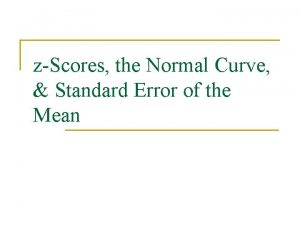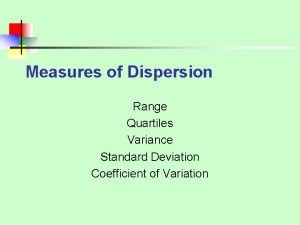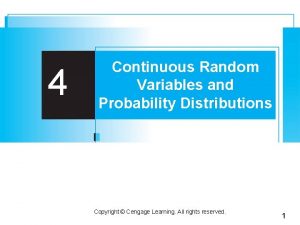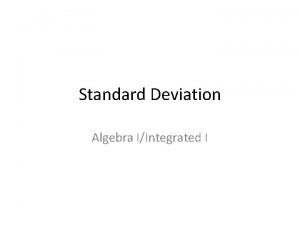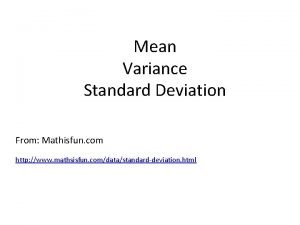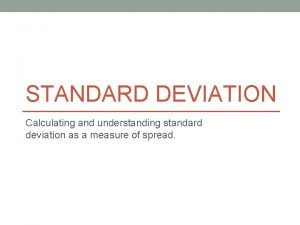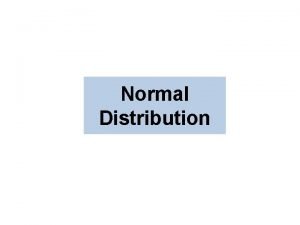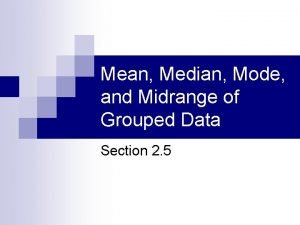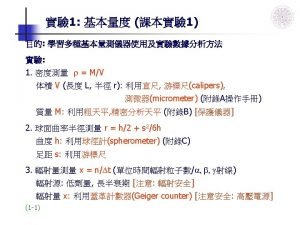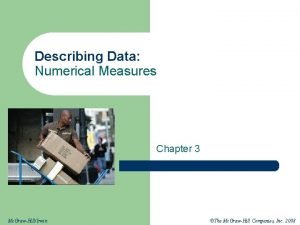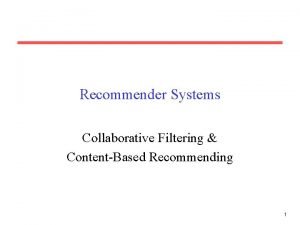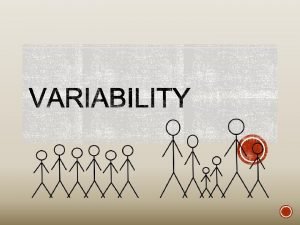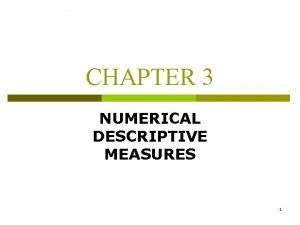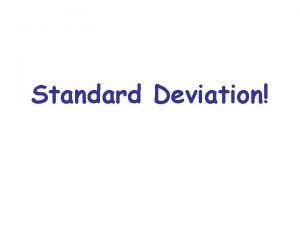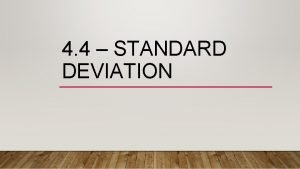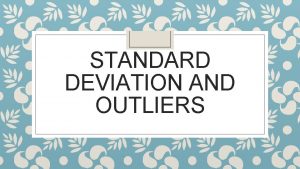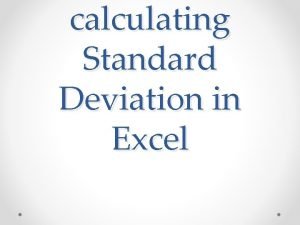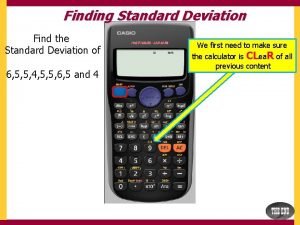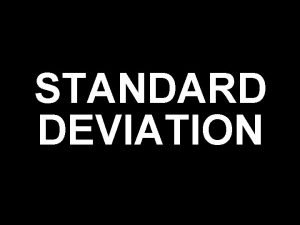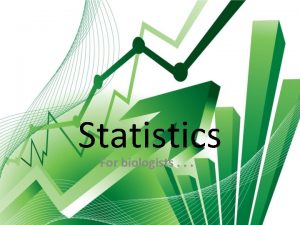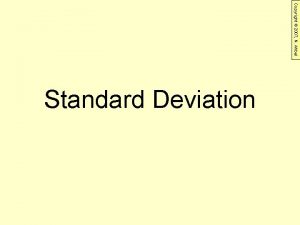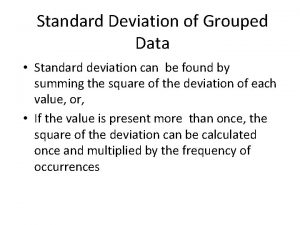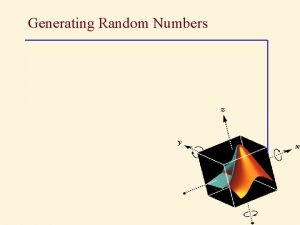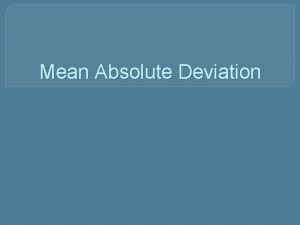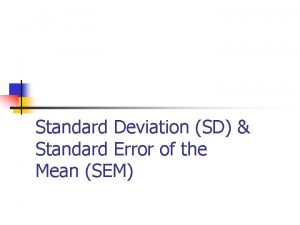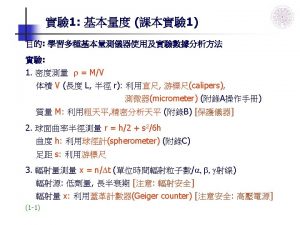Section 5 4 Mean and Standard Deviation of


![For Any Discrete Probability Distribution: Formulas Mean µ = [x • P(x)] = [ For Any Discrete Probability Distribution: Formulas Mean µ = [x • P(x)] = [](https://slidetodoc.com/presentation_image_h/75e20b26e288ae6b1ec5e2bebbf18c9f/image-3.jpg)















- Slides: 18

Section 5. 4 Mean and Standard Deviation of Binomial Probability Distributions

Learning Targets In this section we consider important characteristics of a binomial distribution including center, variation and distribution. That is, given a particular binomial probability distribution we can find its mean, variance and standard deviation. A strong emphasis is placed on interpreting and understanding those values.
![For Any Discrete Probability Distribution Formulas Mean µ x Px For Any Discrete Probability Distribution: Formulas Mean µ = [x • P(x)] = [](https://slidetodoc.com/presentation_image_h/75e20b26e288ae6b1ec5e2bebbf18c9f/image-3.jpg)
For Any Discrete Probability Distribution: Formulas Mean µ = [x • P(x)] = [ x 2 • P(x)] – µ 2 Variance 2 Std. Dev. = [ x 2 • P(x)] – µ 2

Mean and Standard Deviation of the Binomial Probability Distribution Formulas Remember: � � Mean is the same as expected value � This is what you would Where n = number of fixed trials p = probability of success in one of the n trials q = probability of failure in one of the n trials expect the average to be after an infinite number of trials � Standard deviation represents the spread of the data that you would expect to see

Don’t Forget! The Range Rule of Thumb � � This rule remains consistent and true for all probability distributions. It is especially important to interpret results. The range rule of thumb suggests that values are unusual if they lie outside of these limits: Minimum usual values = µ – 2σ Maximum usual values = µ + 2σ

I Really Need to Pea �Assume there is a. 75 probability of a pea having a green pod. How many peas in a set of 5 offspring would you expect to have green pods? This is a question regarding “expected value”, . = np = 5(0. 75) = 3. 75

Example: Assume that a procedure yields a binomial distribution with n trials and the probability of success for one trial is p. Use the given values of n and p to find the mean, µ and standard deviation, σ. Also, use the range rule of thumb to find the minimum usual value, µ – 2σ, and the maximum usual value, µ + 2σ. Random guesses are made for 50 SAT multiple choice questions, so n = 50 and p = 0. 2.

PEAS! �

Are 24% of M&M’s Blue? ? ? �

Are 24% of M&M’s Blue? ? ? �

Your Turn Mars, Inc. claims that 16% of its M&M plain candies are green. A sample of 100 M&Ms is randomly selected. a) Find the mean and standard deviation for the numbers of green M&Ms in such groups of 100. b) Data set 18 in Appendix B consists of a random sample of 100 M&Ms in which 19 are green. Is this result unusual? Does it seem that the claimed rate of 16% is wrong?

It’s a Lot of Boy’s! �

Your Turn: The midterm exam in a nursing course consists of 75 true/false questions. Assume that an unprepared student makes random guesses for each of the answers. a) Find the mean and standard deviation for the number of correct answers for such students. b) Would it be unusual for a student to pass this exam by guessing and getting at least 45 correct answers? Why or why not? Since 38. 8397 < 45 < 46. 1603, it is usual.

Example: A headline in USA Today states that “most stay at first jobs less than 2 years. ” That headline is based on an Expeience. com poll of 320 college graduates. Among those polled, 78% stayed at their first full-time job less than 2 years. a) Assuming that 50% is the true percentage of graduates who stay at their first job less than two years, find the mean and standard deviation of the numbers of such graduates in randomly selected groups of 320 graduates.

Example continue: A headline in USA Today states that “most stay at first jobs less than 2 years. ” That headline is based on an Expeience. com poll of 320 college graduates. Among those polled, 78% stayed at their first full-time job less than 2 years. b) Assuming that the 50% rate in part (a) is correct, find the range of usual values for the number of graduates among 320 who stay at their first job less than two years.

Example continue: A headline in USA Today states that “most stay at first jobs less than 2 years. ” That headline is based on an Expeience. com poll of 320 college graduates. Among those polled, 78% stayed at their first full-time job less than 2 years. c) Find the actual number of surveyed graduates who stayed at their first job less than two years. Use the range values from part (b) to determine whether that number is unusual. Does the result suggest that the headline is not justified? 320(0. 78) = 249. 6 250 Since 250 is not in the range of (142. 1115, 177. 8885), it is unusual high and it suggested that the headline is not justified.

Recap In this section we have discussed: v Mean, variance and standard deviation formulas for any discrete probability distribution. v Mean, variance and standard deviation formulas for the binomial probability distribution. v Interpreting results.

Homework �Pg. 232: 11, 13, 16, 18
 How do you calculate mean absolute deviation
How do you calculate mean absolute deviation Standard error or standard deviation
Standard error or standard deviation How to find percentile rank
How to find percentile rank Range
Range Geometric mean sas
Geometric mean sas Exponential distribution mean and standard deviation
Exponential distribution mean and standard deviation Standard deviation algebra
Standard deviation algebra Mathisfun sigma calculator
Mathisfun sigma calculator Standard deviation example
Standard deviation example Standard deviation normal distribution
Standard deviation normal distribution Median formula grouped data
Median formula grouped data Mean, median mode midrange calculator
Mean, median mode midrange calculator Standard deviation xi
Standard deviation xi Mean median mode standard deviation
Mean median mode standard deviation Mean deviation
Mean deviation Variance and standard deviation formula
Variance and standard deviation formula Red mars
Red mars Range variance and standard deviation
Range variance and standard deviation Chapter 3 numerical descriptive measures
Chapter 3 numerical descriptive measures


